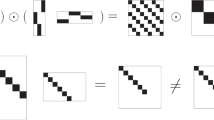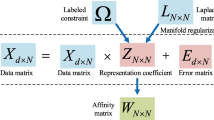Abstract
Adaptive data analysis provides an important tool in extracting hidden physical information from multiscale data that arise from various applications. In this paper, we review two data-driven time-frequency analysis methods that we introduced recently to study trend and instantaneous frequency of nonlinear and nonstationary data. These methods are inspired by the empirical mode decomposition method (EMD) and the recently developed compressed (compressive) sensing theory. The main idea is to look for the sparsest representation of multiscale data within the largest possible dictionary consisting of intrinsic mode functions of the form {a(t) cos(θ(t))}, where a is assumed to be less oscillatory than cos(θ(t)) and θ′ ⩾ 0. This problem can be formulated as a nonlinear l 0 optimization problem. We have proposed two methods to solve this nonlinear optimization problem. The first one is based on nonlinear basis pursuit and the second one is based on nonlinear matching pursuit. Convergence analysis has been carried out for the nonlinear matching pursuit method. Some numerical experiments are given to demonstrate the effectiveness of the proposed methods.
Similar content being viewed by others
References
Bach F R, Jenatton R, Mairal J, et al. Optimization with sparsity-inducing penalties. Found Trends Mach Learn, 2012, 4: 1–106
Boashash B. Time-Frequency Signal Analysis: Methods and Applications. Melbourne/New York: Longman-Cheshire/John Wiley, 1992
Bruckstein A M, Donoho D L, Elad M. From sparse solutions of systems of equations to sparse modeling of signals and images. SIAM Rev, 2009, 51: 34–81
Candès E, Romberg J, Tao T. Robust uncertainty principles: Exact signal recovery from highly incomplete frequency information. IEEE Trans Inform Theory, 2006, 52: 489–509
Candès E, Romberg J, Tao T. Stable signal recovery from incomplete and inaccurate measurements. Comm Pure Appl Math, 2006, 59: 1207–1223
Candès E, Tao T. Decoding by linear programming. IEEE Trans Inform Theory, 2005, 51: 4203–4215
Candès E, Tao T. Near optimal signal recovery from random projections: Universal encoding strategies? IEEE Trans Inform Theory, 2006, 52: 5406–5425
Chen S, Donoho D, Saunders M. Atomic decomposition by basis pursuit. SIAM J Sci Comput, 1998, 20: 33–61
Combettes P L, Pesquet J C. Proximal splitting methods in signal processing. In: Bauschke H H, Burachik R, Combettes P L, et al., eds. Fixed-point Algorithms for Inverse Problems in Science and Engineering. New York: Springer-Verlag, 2010, 185–212
Daubechies I. Ten Lectures on Wavelets. CBMS-NSF Regional Conference Series on Applied Mathematics, vol. 61. Philadelphia: SIAM, 1992
Daubechies I, Lu J, Wu H. Synchrosqueezed wavelet transforms: An empirical mode decomposition-like tool. Appl Comp Harmon Anal, 2011 30: 243–261
Donoho D L. Compressed sensing. IEEE Trans Inform Theory, 2006, 52: 1289–1306
Flandrin P. Time-Frequency/Time-Scale Analysis. San Diego, CA: Academic Press, 1999
Gabor D. Theory of communication. J Inst Elect Eng, 1946, 93: 429–457
Goldstein T, Osher S. The split Bregman method for L 1-regularized problems. SIAM J Imaging Sci, 2009, 2: 323–343
Gribonval R, Nielsen M. Sparse representations in unions of bases. IEEE Trans Inform Theory, 2003, 49: 3320–3325
Gross R S. Combinations of Earth Orientation Measurements: SPACE2000, COMB2000, and POLE2000. JPL Publication 01-2. Pasadena, CA: Jet Propulsion Laboratory, 2001
Hou T Y, Shi Z. Adaptive data analysis via sparse time-frequency representation. Adv Adapt Data Anal, 2011, 3: 1–28
Hou T Y, Shi Z. Data-drive time-frequency analysis. Appl Comput Harmon Anal, 2013, 35: 284–308
Hou T Y, Shi Z. Sparse time-frequency decomposition by adaptive basis pursuit. Preprint
Hou T Y, Shi Z, Tavallali P. Convergence of a data-driven time-frequency analysis method. Appl Comput Harmon Anal, submitted, 2013
Huang N E, Shen Z, Long S R, et al. The empirical mode decomposition and the Hilbert spectrum for nonlinear and non-stationary time series analysis. Proc R Soc Lond Ser A Math Phys Eng Sci, 1998, 454: 903–995
Jomes D L, Parks T W. A high resolution data-adaptive time-frequency representation. IEEE Trans Acoust Speech Signal Process, 1990, 38: 2127–2135
Loughlin P J, Tracer B. On the amplitude- and frequency-modulation decomposition of signals. J Acoust Soc Amer, 1996, 100: 1594–1601
Lovell B C, Williamson R C, Boashash B. The relationship between instantaneous frequency and time-frequency representations. IEEE Trans Signal Process, 1993, 41: 1458–1461
Mallat S. A Wavelet Tour of Signal Processing: the Sparse Way. New York: Academic Press, 2009
Mallat S, Zhang Z. Matching pursuit with time-frequency dictionaries. IEEE Trans Signal Process, 1993, 41: 3397–3415
Meville W K. Wave modulation and breakdown. J Fluid Mech, 1983, 128: 489–506
Needell D, Tropp J. CoSaMP: Iterative signal recovery from noisy samples. Appl Comput Harmon Anal, 2008, 26: 301–321
Needell D, Vershynin R. Uniform uncertainty principle and signal recovery via regularized orthogonal matching pursuit. J Found Comput Math, 2009, 9: 317–334
Olhede S, Walden A T. The Hilbert spectrum via wavelet projections. Proc R Soc Lond Ser A Math Phys Eng Sci, 2004, 460: 955–975
Pahlevan N M, Tavallali P, Petrasek D, et al. Systems science and a novel insight into cardiovascular physiology. Science, submitted, 2013
Pesquet J C, Pustelnik N. A parallel inertial proximal optimization method. Pacific J Optim, 2012, 8: 273–305
Picinbono B. On instantaneous amplitude and phase signals. IEEE Trans Signal Process, 1997, 45: 552–560
Qian S, Chen D. Signal representation using adaptive normalized Gaussian functions. Signal Processing, 1994, 36: 1–11
Qian S, Chen D. Joint Time-Frequency Analysis: Methods and Applications. New York: Prentice Hall, 1996
Rice S O. Mathematical analysis of random noise. Bell Syst Tech J, 1944, 23: 282–310
Setzer S, Steidl G, Teuber T. Deblurring Poissonian images by split Bregman techniques. J Visual Commun Image Rep, 2010, 21: 193–199
Shekel J. Instantaneous frequency. Proc IRE, 1953, 41: 548–548
Shi Y, Li K F, Yung Y L, et al. A decadal microwave record of tropical air temperature from AMSU-A/Aqua observations. Climate Dynamics, in press, 2013, doi: 10.1007/s00382-013-1696-x
Tropp J, Gilbert A. Signal recovery from random measurements via orthogonal matching pursuit. IEEE Trans Inform Theory, 2007, 53: 4655–4666
Van der Pol B. The fundamental principles of frequency modulation. Proc Inst Elect Eng, 1946, 93: 153–158
Wu H T. Instantaneous frequency and wave shape functions (I). Appl Comput Harmon Anal, 2012, in press, doi: 10.1016/j.acha.2012.08.008
Wu Z, Huang N E. Ensemble Empirical Mode Decomposition: A noise-assisted data analysis method. Adv Adapt Data Anal, 2009, 1: 1–41
Wu Z, Huang N E, Long S R, et al. Trend, detrend, and the variability of nonlinear and non-stationary time series. Proc Natl Acad Sci USA, 2007, 104: 14889–14894
Author information
Authors and Affiliations
Corresponding author
Additional information
Dedicated to Professor Shi Zhong-Ci on the Occasion of his 80th Birthday
Rights and permissions
About this article
Cite this article
Hou, T.Y., Shi, Z. Sparse time-frequency representation of nonlinear and nonstationary data. Sci. China Math. 56, 2489–2506 (2013). https://doi.org/10.1007/s11425-013-4733-7
Received:
Accepted:
Published:
Issue Date:
DOI: https://doi.org/10.1007/s11425-013-4733-7




